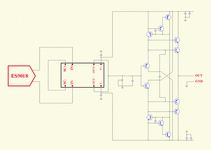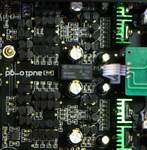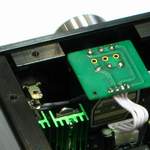|
About NFB?
The NFB-11 applies the newest ESS high-end Sabre32 DA chip
ES9018 which can support up to 32Bit/384KHz input .
To
be achieve the best performance of ES9018 , must work in
current output model, in voltage output model, there is -12DB THD+N worst .
The standard current model design
usually need 3 amps (OPA) ,
the first amp implement I/V conversion, conversion the ES9018 output
current signal to voltage signal .
The second amp is the difference amp,
conversion the balance signal to single-ended signal and implement
the low pass analog filter , then through volume control feed to the third amp, the headphone amp
.
Every amp usually have two gain stages
built in so the ES9018 signal must through
total 6 gain stages arrive the output stages .
The
NFB-11 applies Non-feedback ACSS design. The ES9018 feed to the ACSS
circuit without any OPAs .
The ACSS circuit naturally working in
current model and have design difference current input , it can
process the I/V conversion, signal difference and headphone amp in current
model in one ACSS amp . And this ACSS amp only have one current gain
stage ,
the ES9018 output signal only through one stage can arrive the output stages .
The shortest signal journey can reproduce the best
detail and dynamic, and almost without sound coloration , It can
show the real performance of the ES9018 .
So our ACSS design is the best combo with
ES9018 achieve the best performance .
Upside in the picture is the standard ES9018 headphone amp design.
The bottom is the NFB-11 design .
Click image to enlarge.

The ACSS also is a non-feedback
technology made with fully discrete amplifiers. Most people know the
global
feedback design can offer better specs in test measurements, and
non-feedback can't do well in test measurements but can offer better
sound for the human's ears. Here is a conflict of the classic circuits.
But the ACSS opens a new field, it can offer a least coloration sound
which is more neutral with very low distortion and high linearity. So
it can retain the dynamics, detail and neutral sound but not sound
bright or harsh.
The output buffers are
Non-feedback. For low impedance, we applied a diamond output stage
which is quite less colored than most conventional circuits.
The DAC is without couple
caps to avoid coloration. There are two OPAs built in as the DC serve to
keep the DC offset .
The 32bit / 384K USB interface
outputs a I2S signal to ES9018 .
Fully
Discrete ACSS headphone amp.
Click image to enlarge.


NFB-11 applies the excellent DA chip ES9018 and excellent analog
output stages, but these are not the only keys of the best sound.
The power supply is most important. Even applying the best DA chip
and the best amp, if matched to a average power supply, the total
sound may still be average or sound musical but can't be neutral and
detailed. That is why it is easy to find hi-end grade gears maybe
without the best chips , but with plenteous dedicated
DC supply circuits.
The
NFB-11
uses 6 groups of high-quality PSU
with dedicated DC
supply. Digital and analog voltages each have separately isolated
internal power regulations.
This massive power supplies
design usually only applied in the USD1000+ products .
The
analog power supply is more important for sound reproduce, in NFB-11,
the +15V and -15V for the analog output stages are high speed
Discrete PSU. They can offer pure and quick power supply for driving
the headphone exactly. The high voltage power supply can drive most
headphone from 15 to 600 ohms as well.
Strong power supply.
Click image to enlarge.


About volume in ACSS circuits:
For a headphone amp, the
volume control is very important.
In ACSS, it is placed at the
ACSS modules output, where the output is the current signal, not the
voltage signal. The volume control is I/V conversion, and the volume
depends on the current (I) conversion to the voltage (V). (Like D/A
chips output I/V conversion)
As you can see, ACSS circuits have no
gain, as it is a completely different circuit.
The sound quality benefits from I/V
conversion volume control. Mark Levinson also knows that current
volume control has great benefits, so in their Top End preamp NO.32
volume control, they use many components to change the signal to
current signal (I), then through the R-2R network to control the
volume, and then change back to voltage signal (V) again. But NFB-11 is simply a more complete work in terms of the current signal,
and technically, it is superior to conventional technology.
ALPS 27 volume pot 1 % tolerance
resistors and exact match transistors
Click image to enlarge.

 |

